CTID: SUDDEN ENDINGS
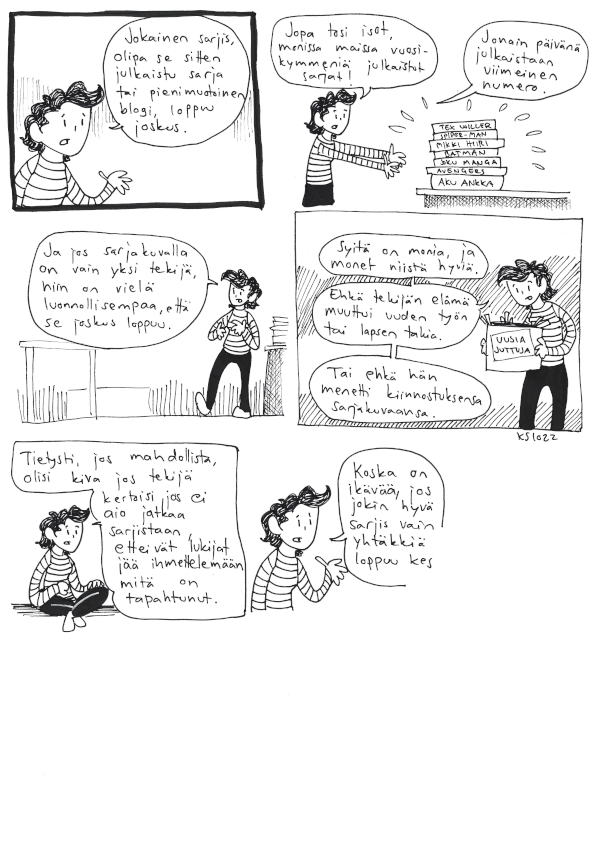
”Every comic, whether it is a published series or a small blog, end at some point.” //
”Even the really big ones that have been published in many countries for decades! One day it’ll be the very last issue.” //
”And if the comic only has one maker it is even more natural that one day it will end.” //
”There are many reasons for this, and many of them are good, Maybe the artist’s life was changed due to a new job or a baby. Or maybe they lost interest in their comic.” //
”Of course, if possible, it would be nice if the artist would tell that they’re not going to continue with their comic so that the readers won’t be left wondering what has happened.” //
”Because it’s very dull if a good comic just suddenly en
Aihearkisto: Nörtteilyä
SJEP: Muuttuva tyyli
CTID: CHANGING STYLES
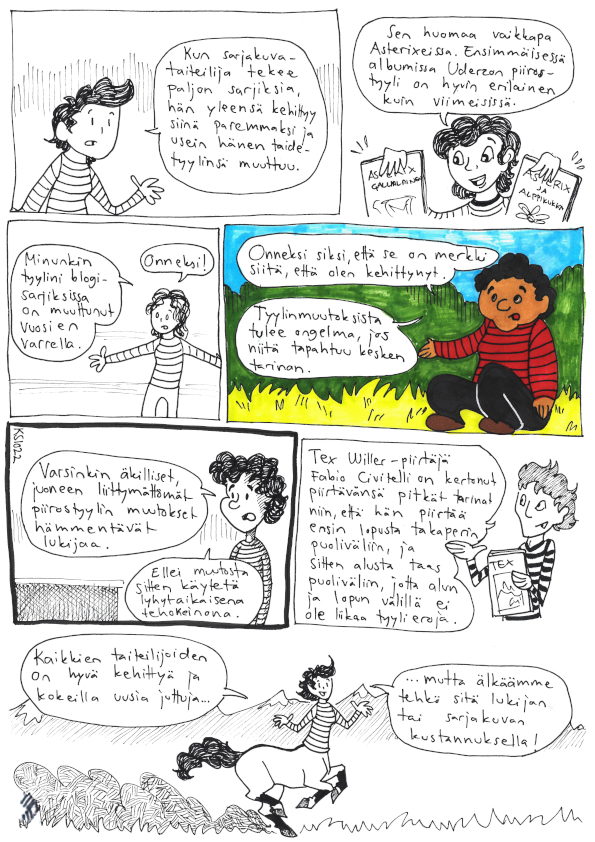
”When a comic artist makes a lot of comics, they mostly get better at it and often their art style changes.” //
”You can see it in Asterix comics, for example. In the first album, Uderzo’s drawing style is very different than in the last.” //
”Even in my blog the style has changed over the years. Luckily!” //
”I say luckily because it’s a sign that I have developed. Changing styles become a problem if it happens in the middle of the story.” //
”Especially sudden, not plot-related changes in the art style confuse the reader. Unless it is used a short-term effect.” //
”The Tex Willer artist Fabio Civitelli has said that he draws long stories by beginning at the end, drawing backwards to the midpoint and then taking it up from the beginning and drawing again to the middle. This is so that the style in the beginning and in the end would be as close to each other as possible.” //
”It is important for every artist to develop and try new stuff… but let’s not sacrifice the comic or the reader to this change!”
SJEP: Jännät ruudut
CTID: INTERESTING PANELS

”One thing you oftentimes see in comic drawing guides…” //
”…is that you should use interestingly shaped (=non-rectangular) panes to make the page look more interesting.” //
”I myself hate this. It CAN work, for example it is often used in manga.” //
”But in-between interestingly shaped panels there is often unused space… like here and there!” //
”Of course you can modify rectangles such as with this speech bubble trick – but the basic shape is still a rectangle! JP Ahonen uses this a lot in the Northern Overexposure comics.” //
”In actin scenes and scenes that are confusing to a character interestingly shaped panels are a good special effect. But in peaceful scenes they’re more a disturbance.” //
”You also have to be careful not to mess the reading order…” There? Or there? //
”Interestingly shaped panels can easily make the page restless and confusing!” Earthquake? //
”When used well and sparingly, non-rectangular panels can create a sense of action or other effects…” //
”…but mostly I would recommend that you’re stick to rectangles.”
SJEP: Selityslaatikot
CTID: EXPLANATION BOXES
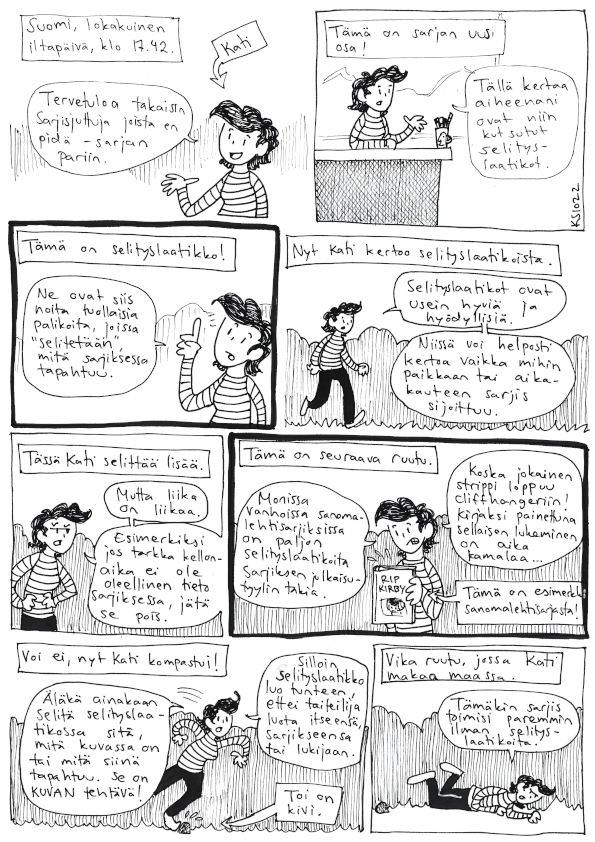
Finland, an afternoon in October, 5.42 pm. Kati. ”Welcome back to the Comic Things I Dislike series.” //
This is the newest episode of the series! ”Today my topic are explanation boxes.” //
This is an explanation box! ”By them I mean those small panels in which it is explained what is happening in the comic.” //
Now Kati will talk about explanation boxes. ”Explanation boxes are often good and useful. You can, for example, tell the location or time period of the comic in them.” //
Here Kati talks more. ”But too much is too much. For example, if the exact time isn’t important, just leave it out.” //
Here’s the next panel. ”Many old newspaper comics have plenty of explanation boxes because of how they were published. Because every strip ends with a cliffhanger! Reading it as a book is pretty terrible…” This is an example of a newspaper comic! //
Oh no, no Kati stumbled! ”And just don’t use the explanation box to explain what is in the picture or what is happening in it. That’s the picture’s job! Using an explanation box like this gives the feeling that the artist doesn’t trust themselves, their comic or the reader.” That is a rock. //
This is the last panel where Kati is laying on the ground. ”Even this comic would be better without the explanation boxes.”
SJEP: !
CTID: !
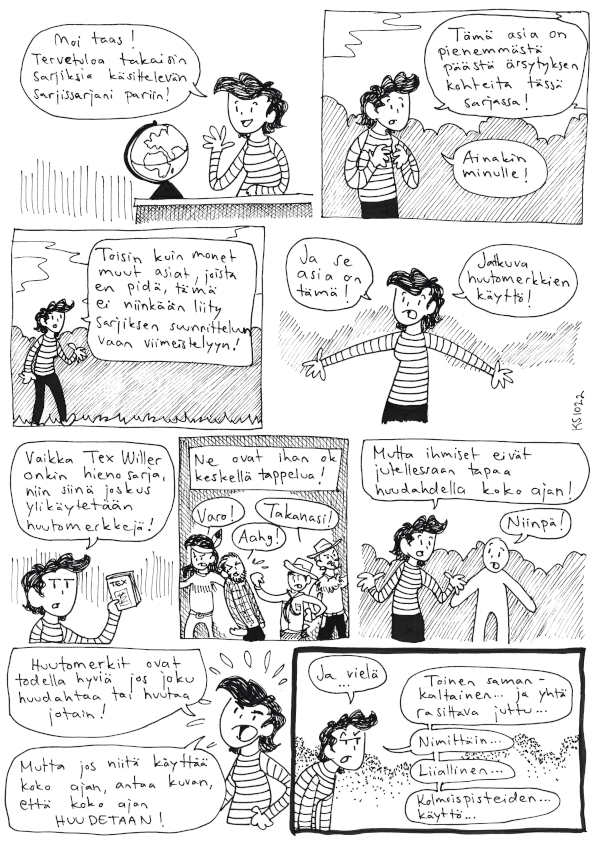
”Hello again! Welcome back to my comic series about comics!” //
”This one is one of the no-so-annoying ones in this series! At least to me!” //
”Unlike many of the other topics, this one doesn’t have that much to do with the planning but more with the finishing!” //
”And this is the thing! Constant usage of exclamation points!”
”Even though Tex Willer is a great comic it sometimes overuses exclamation points!” //
They are all right in a fight scene! ”Look out!” ”Aagh!” ”Behind you!” //
”But people don’t tent to exclaim constantly when they’re talking!” ”Indeed!” //
”Exclamation marks are really useful if someone is actually exclaiming or shouting something! But if they’re used all the time it just looks that everyone is constantly YELLING!” //
”And now… Another pretty similar… and equally annoying thing… Which is… Constantly… overusing… ellipses…”
Huomasin sittemmin, että ”…” on ”pistekolmikko” tai ”ellipsi”. Kolmoispiste taas liittyy fysiikkaan ja on se lämpötilan ja paineen suhteen ”optimaalinen” kohta, jossa aineen kolme olomuotoa eli kaasu, neste ja kiinteä, ovat tasapainossa. En tajunnut tätä tussatessani.
SJEP: Väärin asetellut puhekuplat
CTID: SPEECH BUBBLES PLACED WRONG
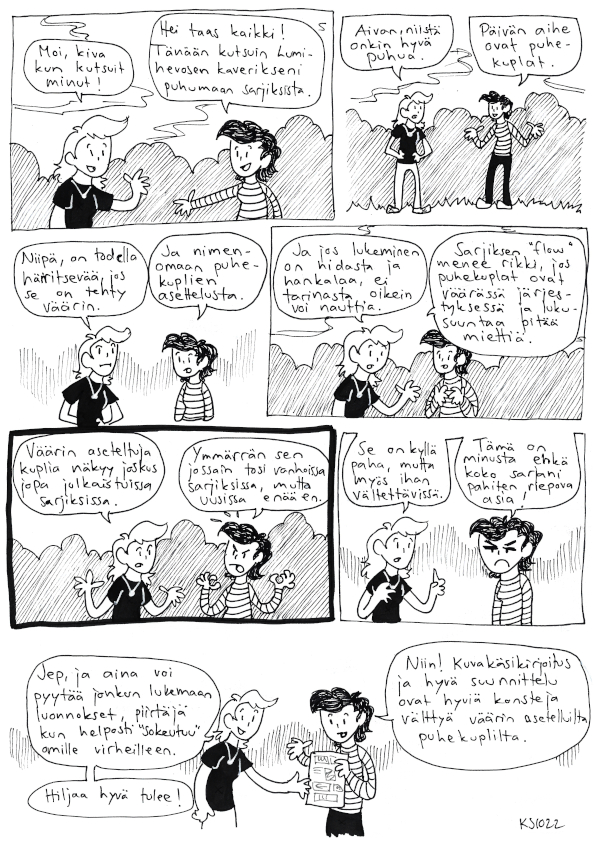
”Hi, so nice that you invited me!” ”Hello again, everyone! Today I invited Snowhorse to talk about comics with me.” //
”Yes, they’re an important topic.” ”Today’s topic is speech bubbles.” //
”Indeed, it is very annoying if it’s done wrong.” ”And especially the placing of speech bubbles.” //
”And if reading is slow and difficult you can’t really enjoy the story.” ”The ’flow’ of the comic is broken if the speech bubbles are placed in a wrong order and you have to think about which order to read them in.” //
”You sometimes even see wrongly place speech bubbles in published comics.” ”I understand it in some really old comics but not in new ones.” //
”It is bad all right, but also avoidable.” ”To me, this is probably the most annoying thing in this whole series!” //
”Yep, and you can always ask someone to read your sketches because the artist often becomes ’blind’ to their own mistakes. Slowly does it!” ”Yes! Good planning and making a storyboard are good ways to avoid placing your speech bubbles wrong.”
SJEP: Tunkeminen
CTID: CRAMMING
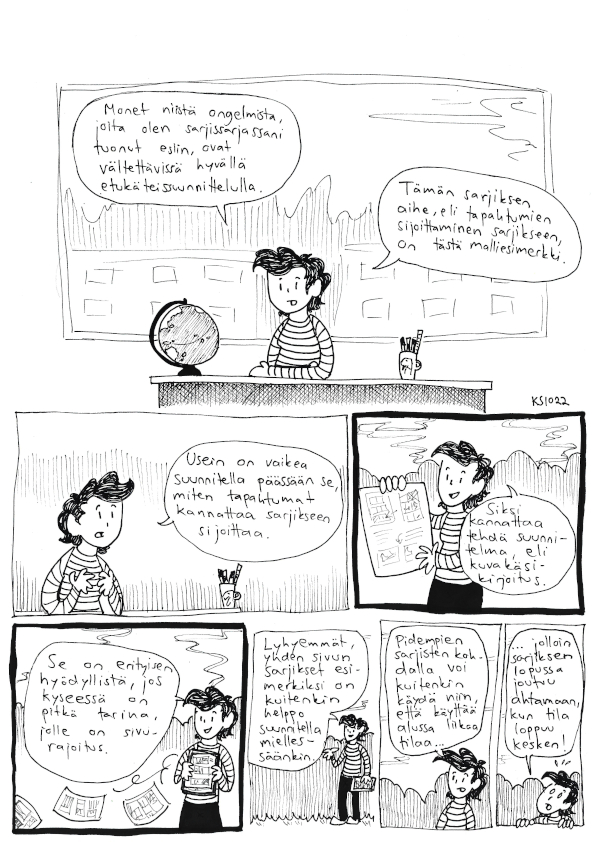
”Many of the problems I have discussed in my comic series are avoidable with good before-hand planning. The topic of this comic, placing things in the comic, is a great example of this.” //
”It is often difficult to plan in your mind how you’re going to place everything in your comic.” //
”That’s why you should plan ahead and make a storyboard.” //
”It is especially useful if you’re making a longer story with a page limitation.” //
”Shorter comics, such as one-page-long strips are still easy to plan in your head.” //
”But with longer comics you might use up too much space in the beginning…” //
”…and in the end you have to cram when you run out of space!”
SJEP: Tekstimuurit
CTID: TEXT WALLS
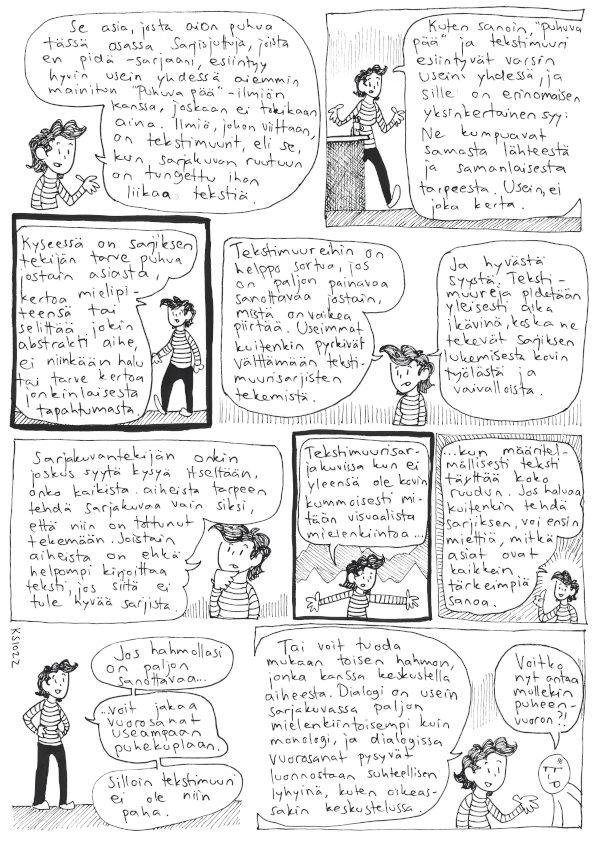
”The thing I’m going to talk about in this part of my series of Comic Things I Dislike often appears with the ’talking heads’ phenomenon mentioned earlier, though of course not always. What I’m referring to here is text walls which means that the panels are filled with way too much text.” //
”As I said, ’talking heads’ and text walls quite often appear together, and there is one very good reason for this. They come from the same place and same kind of need. Often, not every time.” //
”What I mean here is the comic maker’s need to talk about something, tell their opinion or explain some abstract concept, not so much the want or need to tell about something that has happened.” //
”One easily falls victim to a text wall if one has important things to say about something that is difficult to draw about. However, most comic creators try to avoid making text wall comics. And for a good reason, too. Text walls are mostly considered pretty boring as they make reading the comic painstaking and slow.” //
”Sometimes it is a good idea for a comic maker to ask themselves if it is necessary to make a comic about some topic just because they’re used to do so. Maybe it is better to just write about certain things if they don’t make good comics.” //
”Because text wall comics often aren’t visually that interesting…” //
”…as the text by definition fills most of the panel. If you still want to make that comic, think first about which things are the most important ones to say.” //
”If your character has plenty to say… you can divide their lines into more than one speech bubble. Then the text wall doesn’t look that bad.” //
”Or you can bring in another character with whom to discuss the topic. A dialogue is often much more interesting in comics than a monologue, and like in real life conversation, in a dialogue the lines naturally stay shorter.” ”Could you please let me talk here, too?”
SJEP: Puhuvat päät
CTID: TALKING HEADS
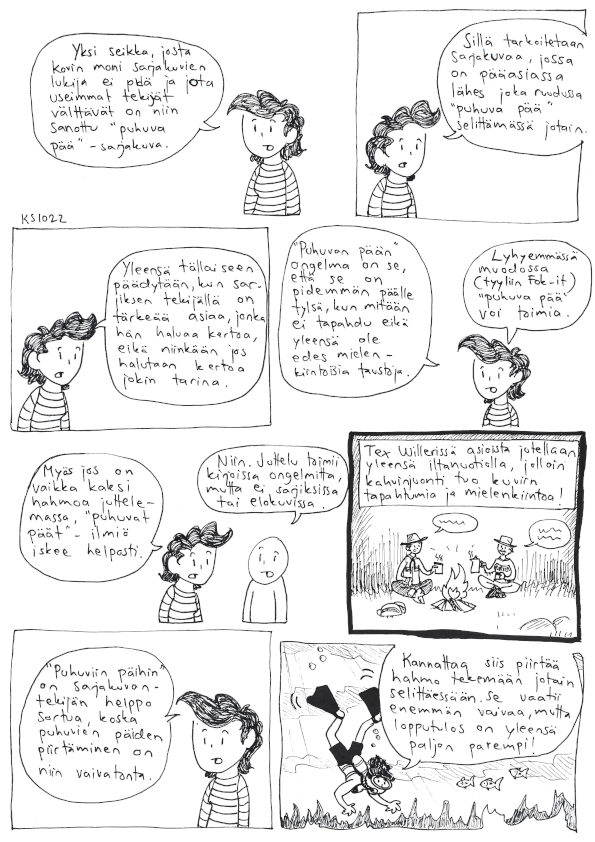
”One thing that many comic readers don’t like and most comic artists try to avoid is so-called ’talking heads’ comic.” //
”It means a comic in which in almost every panel there is a ’talking head’ explaining something.” //
”Mostly you end up with this when the comic maker has something important they want to say, not so much if they have a story to tell.”
”The problem with the ’talking head’ is that it get quickly boring as nothing happens and mostly the backgrounds aren’t that interesting, either. In shorter form, such as in Fok_it, the ’talking head may work.” //
”The ’talking head’ phenomenon easily happens also if you have two people discussing something.” ”Indeed. Conversations work without problems in books but not so easily in comics or movies.” //
In Tex Willer the characters mostly discuss by campfires where making coffee brings something visually interesting the the panels! //
”Comic artists easily fall for ’talking heads’ because they’re so easy to draw.” //
”So it’s a good idea to draw the character doing something while they’re explaining stuff. It’s more work when drawing but the end result is usually much better!”
SJEP: Epäselvä käsiala
CTID: UNREADABLE HANDWRITING
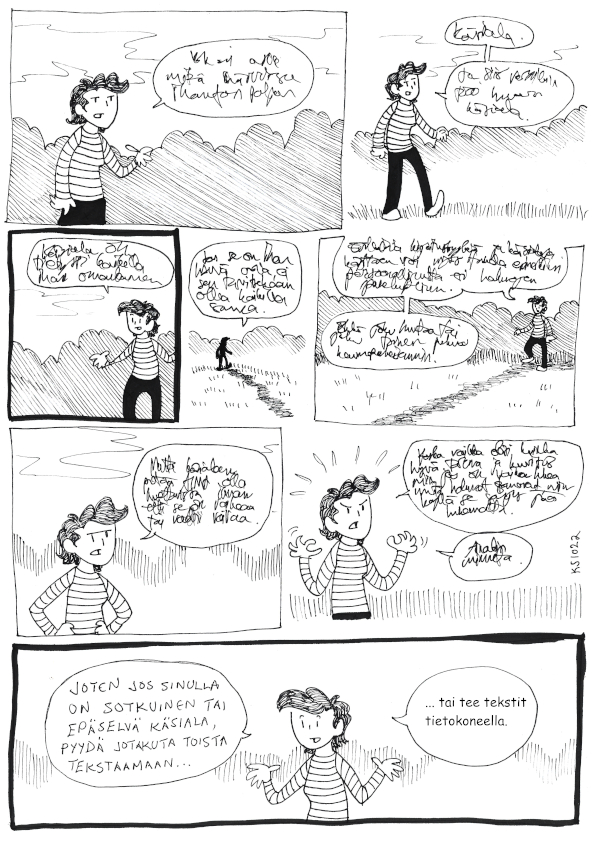
(Illegible handwriting)
”So if your handwriting is messy or unreadable, ask someone else to letter your comics… or do it by computer.”
Jos et jaksanut lukea sotkujani, niin näin siinä lukee:
”Yksi asia, mikä häiritsee ihan tosi paljon.” //
”Käsiala. Ja siis varsinkin tosi huono käsiala.” //
”Käsiala on tietysti kaikilla ihan omanlainen.” //
”Ja se on ihan hyvä asia, ei sen tarvitsekaan olla kaikilla sama.” //
”Erilaisia kirjoitustyylejä ja käsialoja käyttäen voi myös tuoda esimerkiksi persoonallisuutta eri hahmojen puhekupliin. Ehkä joku huutaa tai joku toinen puhuu kaunopuheisemmin.” //
”Mutta käsialan pitää AINA olla luettavissa ilman että se on vaikeaa tai vaatii vaivaa.” //
”Koska vaikka olisi kuinka hyvä tarina ja kuvitus, niin jos on vaikea lukea, mitä hahmot sanovat, niin kyllä se sarjis jää lukematta. Ainakin minulta.”
Here’s what’s written in that terrible handwriting:
”One thing that really annoys me.” //
”Handwriting. And I mean bad handwriting.” //
”Everyone of course has their own style of writing by hand.” //
”And that’s a good thing, not everyone’s handwriting has to be the same.” //
”By using different types of writing and lettering you can, for example, also bring personality to different characters’ speech bubbles. Maybe someone is shouting and someone else is more eloquent.” //
”But handwriting must ALWAYS be legible without it being hard or taking too much effort.” //
”Because even if the story and the drawings are really good, if the text is difficult to read, then the reader is not going to read it. At least I won’t.”
PS. Kiitos äidilleni viimeisen ruudun puhekuplan tekstaamisesta.
PS. Thanks to my mom for lettering the speech bubble in the last panel.
PPS. Tottakai se on Comic Sans, mitä muutakaan odotitte?
PPS. Of course it’s Comic Sans, what were you expecting?
